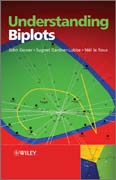
INDICE: Preface. 1 Introduction. 1.1 Types of biplots. 1.2 Overview of the book. 1.3 Software. 1.4 Notation. 2 Biplot basics. 2.1 A simple example revisited. 2.2 The biplot as a multidimensional scatterplot. 2.3 Calibrated biplot axes. 2.4 Refining the biplot display. 2.5 Scaling the data. 2.6 A closer look at biplot axes. 2.7 Adding new variables: the regression method. 2.8 Biplots and large data sets. 2.9 Enclosing a configuration of sample points. 2.10 Buying by mail order catalogue data set revisited. 2.11 Summary. 3 Principal component analysis biplots. 3.1 An example: risk management. 3.2 Understanding PCA and constructing its biplot. 3.3 Measures of fit for PCA biplots. 3.4 Predictivities of newly interpolated samples. 3.5 Adding new axes to a PCA biplot and defining their predictivities. 3.6 Scaling the data in a PCA biplot. 3.7 Functions for constructing a PCA biplot. 3.8 Some novel applications and enhancements of PCA biplots. 3.9 Conclusion. 4 Canonical variate analysis biplots. 4.1 Anexample: revisiting the Ocotea data. 4.2 Understanding CVA and constructing its biplot. 4.3 Geometric interpretation of the transformation to the canonicalspace. 4.4 CVA biplot axes. 4.5 Adding new points and variables to a CVA biplot. 4.6 Measures of fit for CVA biplots. 4.7 Functions for constructing a CVA biplot. 4.8 Continuing the Ocotea example. 4.9 CVA biplots for two classes. 4.10 A five-class CVA biplot example. 4.11 Overlap in two-dimensional biplots. 5Multidimensional scaling and nonlinear biplots. 5.1 Introduction. 5.2 The regression method. 5.3 Nonlinear biplots. 5.4 Providing nonlinear biplot axes forvariables. 5.5 A PCA biplot as a nonlinear biplot. 5.6 Constructing nonlinearbiplots. 5.7 Examples. 5.8 Analysis of distance. 5.9 Functions AODplot and PermutationAnova. 6 Two-way tables: biadditive biplots. 6.1 Introduction. 6.2 A biadditive model. 6.3 Statistical analysis of the biadditive model. 6.4 Biplots associated with biadditive models. 6.5 Interpolating new rows or columns. 6.6 Functions for constructing biadditive biplots. 6.7 Examples of biadditive biplots: the wheat data. 6.8 Diagnostic biplots. 7 Two-way tables: biplots associated with correspondence analysis. 7.1 Introduction. 7.2 The correspondence analysis biplot. 7.3 Interpolation of new (supplementary) points in CA biplots.7.4 Other CA related methods. 7.5 Functions for constructing CA biplots. 7.6 Examples. 7.7 Conclusion. 8 Multiple correspondence analysis. 8.1 Introduction. 8.2 Multiple correspondence analysis of the indicator matrix. 8.3 The Burt matrix. 8.4 Similarity matrices and the extended matching coefficient. 8.5 Category-level points. 8.6 Homogeneity analysis. 8.7 Correlational approach. 8.8 Categorical (nonlinear) principal component analysis. 8.9 Functions for constructing MCA related biplots. 8.10 Revisiting the
- ISBN: 978-0-470-01255-0
- Editorial: John Wiley & Sons
- Encuadernacion: Cartoné
- Páginas: 480
- Fecha Publicación: 07/01/2011
- Nº Volúmenes: 1
- Idioma: Inglés
